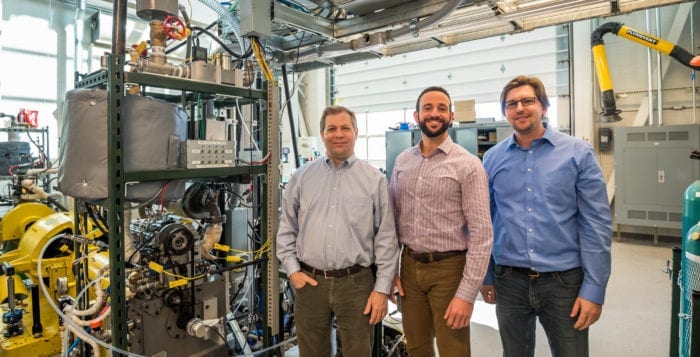By Daniel Dunaief
It’s not exactly Coke and Pepsi designing a better soda. It’s not Nike and Reebok creating a more efficient sneaker. And, it’s not McDonald’s and Burger King uniting the crown and the golden arches. At Stony Brook University, it is, however, a combination of energy systems that haven’t historically worked together.
“Fuel cells and engines have been seen as competing technologies,” said Sotirios Mamalis, an assistant professor of mechanical engineering at SBU. “The truth of the matter is that these two technologies are very complementary because of their operating principals.”
Indeed, Mamalis is the principal investigator on a multi-year project to create a hybrid fuel cell-engine system that recently won a $2.3 million award from the Department of Energy’s Advanced Research Projects Agency-Energy.
Working with Benjamin Lawler and Jon Longtin at Stony Brook and Tom Butcher, leader of the Energy Conversion Group at Brookhaven National Laboratory, Mamalis plans to build a system that uses solid oxide fuel cells partnered with a split-cylinder, internal combustion engine. The engine system will use the tail gas from the fuel cell to provide additional power, turning the inefficiency of the fuel cell into a source of additional energy.
“These ARPA-E awards are extremely competitive,” said Longtin, adding “If you land one of these, especially a decent-sized one like this, it can move the needle in a lot of ways in a department and at the university level.” The group expects that this design could create a system that generates 70 percent fuel to electricity efficiency. That is well above the 34 percent nationwide average.
Reaching that level of energy efficiency would be a milestone, said Longtin, a Professor in the Department of Mechanical Engineering at Stony Brook. The core of the idea, he suggested, is to take the exhaust from fuel cells, which has residual energy, and run that through a highly tuned, efficient internal combustion engine to extract more power. The second part of the innovation is to repurpose the cylinders in the engine to become air compressors. The fuel cell efficiency increases with higher pressure.
A fuel cell is a “highly efficient device at taking fuel and reacting it to produce DC electricity,” Lawler said. One of its down sides, aside from cost, is that it can’t respond to immediate needs. An engine is the opposite and is generally good at handling what Lawler described as transient needs, in which the demand for energy spikes.
The idea itself is ambitious, the scientists suggested. “These projects are high-risk, high-reward,” said Mamalis. The risks come from the cost and the technical side of things.
The goal is to create a system that has a disruptive role in the power generation market. To succeed, Mamalis said, they need to bring something to market quickly. Their work involves engineering, analysis and design prior to building a system. The project could involve more tasks to reduce technical risk but “we’re skipping a couple of steps so we can demonstrate a prototype system sooner than usual,” Mamalis said.
They will start by modeling and simulating conditions, using mathematical tools they have developed over the years. Once they have modeling results, they will use those to guide specific experimental testing. They will take data from the engine simulation and will subject the engine to conditions to test it in a lab.
“The biggest challenges will be in changing the operation of each of these two technologies to be perhaps less than optimal for each by itself and then to achieve an integrated system that ends up far better,” Butcher explained in an email. “The target fuel-to-electricity efficiency will break barriers and be far greater than is achieved by conventional power plants today.”
Butcher, whose role will be to provide support on system integration concepts and testing, suggested that this could be a part of distribution power generation, where power is produced locally in addition to central power plants. People have looked into hybrid fuel cell-gas turbine systems in the past and a few have been installed and operational, Mamalis explained. The problem is with the cost and reliability.
Mamalis and his colleagues decided they can tap into the inefficiency of fuel cells, which leaves energy behind that a conventional engine can use. The reason this works is that the fuel cell is just inefficient enough, at about 55 percent, to provide the raw materials that a conventional engine could use. A fuel cell that was more efficient, at 75 or 80 percent, would produce less unused fuel in its exhaust, limiting the ability of the system to generate more energy.
The team needs to hit a number of milestones along the way, which are associated with fuel cell development and engine and hybrid system development.
The first phase of the work, for which the team received $2.3 million, will take two years. After the group completes Phase I, it will submit an application to ARPA-E for phase II, which would be for an additional $5 million.
Lawler suggested that fundamental research made this kind of applied project with such commercial potential possible. “The people who did fundamental work and [were involved in] the incremental steps led us to this point,” he said. “Incremental work leads to ground-breaking ideas. You can’t predict when groundbreaking work will happen.”
The other researchers involved in this project credit Mamalis for taking the lead on an effort that requires considerable reporting and updating with the funding agency.
Every three months, Mamalis has to submit a detailed report. He also participates in person and on conference calls to provide an update. He expects to spend about 90 percent of his time on a project for which the team has high hopes.
“It’s an exciting time to be a part of this,” Longtin said. “These folks are pivotal and we have developed into a very capable team, and we have been setting our sights on larger, more significant opportunities.”





